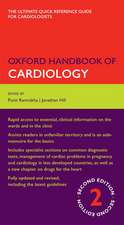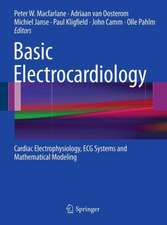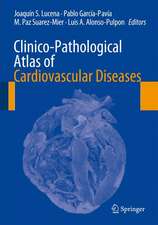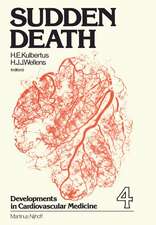Maximal Myocardial Perfusion as a Measure of the Functional Significance of Coronary Artery Disease: From a Pathoanatomic to a Pathophysiologic Interpretation of the Coronary Arteriogram: Developments in Cardiovascular Medicine, cartea 127
Autor N.H. Pijlsen Limba Engleză Hardback – 31 oct 1991
Din seria Developments in Cardiovascular Medicine
- 5%
 Preț: 1484.53 lei
Preț: 1484.53 lei - 5%
 Preț: 375.17 lei
Preț: 375.17 lei - 5%
 Preț: 354.10 lei
Preț: 354.10 lei - 5%
 Preț: 1419.03 lei
Preț: 1419.03 lei - 5%
 Preț: 376.43 lei
Preț: 376.43 lei - 5%
 Preț: 1098.27 lei
Preț: 1098.27 lei - 5%
 Preț: 1438.38 lei
Preț: 1438.38 lei - 5%
 Preț: 376.78 lei
Preț: 376.78 lei - 5%
 Preț: 368.37 lei
Preț: 368.37 lei - 5%
 Preț: 380.25 lei
Preț: 380.25 lei - 5%
 Preț: 2117.58 lei
Preț: 2117.58 lei - 5%
 Preț: 367.28 lei
Preț: 367.28 lei - 5%
 Preț: 366.56 lei
Preț: 366.56 lei - 5%
 Preț: 371.10 lei
Preț: 371.10 lei - 5%
 Preț: 370.94 lei
Preț: 370.94 lei - 5%
 Preț: 783.18 lei
Preț: 783.18 lei - 5%
 Preț: 713.18 lei
Preț: 713.18 lei - 5%
 Preț: 1098.27 lei
Preț: 1098.27 lei - 5%
 Preț: 375.49 lei
Preț: 375.49 lei - 5%
 Preț: 373.47 lei
Preț: 373.47 lei - 5%
 Preț: 723.93 lei
Preț: 723.93 lei - 5%
 Preț: 1104.13 lei
Preț: 1104.13 lei - 5%
 Preț: 2117.20 lei
Preț: 2117.20 lei - 5%
 Preț: 716.09 lei
Preț: 716.09 lei - 5%
 Preț: 372.03 lei
Preț: 372.03 lei - 5%
 Preț: 722.33 lei
Preț: 722.33 lei - 5%
 Preț: 660.07 lei
Preț: 660.07 lei - 5%
 Preț: 375.34 lei
Preț: 375.34 lei - 5%
 Preț: 1423.22 lei
Preț: 1423.22 lei - 5%
 Preț: 715.35 lei
Preț: 715.35 lei - 5%
 Preț: 790.69 lei
Preț: 790.69 lei - 5%
 Preț: 720.68 lei
Preț: 720.68 lei - 5%
 Preț: 3185.49 lei
Preț: 3185.49 lei - 5%
 Preț: 1418.27 lei
Preț: 1418.27 lei - 5%
 Preț: 784.64 lei
Preț: 784.64 lei - 5%
 Preț: 714.63 lei
Preț: 714.63 lei - 5%
 Preț: 376.22 lei
Preț: 376.22 lei - 5%
 Preț: 660.85 lei
Preț: 660.85 lei - 5%
 Preț: 368.37 lei
Preț: 368.37 lei
Preț: 370.74 lei
Preț vechi: 390.25 lei
-5% Nou
Puncte Express: 556
Preț estimativ în valută:
70.96€ • 77.11$ • 59.65£
70.96€ • 77.11$ • 59.65£
Carte tipărită la comandă
Livrare economică 21 aprilie-05 mai
Preluare comenzi: 021 569.72.76
Specificații
ISBN-13: 9780792314301
ISBN-10: 0792314301
Pagini: 186
Ilustrații: XVI, 186 p.
Dimensiuni: 155 x 235 x 13 mm
Greutate: 0.47 kg
Ediția:1991
Editura: SPRINGER NETHERLANDS
Colecția Springer
Seria Developments in Cardiovascular Medicine
Locul publicării:Dordrecht, Netherlands
ISBN-10: 0792314301
Pagini: 186
Ilustrații: XVI, 186 p.
Dimensiuni: 155 x 235 x 13 mm
Greutate: 0.47 kg
Ediția:1991
Editura: SPRINGER NETHERLANDS
Colecția Springer
Seria Developments in Cardiovascular Medicine
Locul publicării:Dordrecht, Netherlands
Public țintă
ResearchCuprins
1 Introduction.- 1.1 The limited value of classical coronary arteriography to predict the physiologic significance of coronary artery stenoses.- 1.2 Coronary flow reserve.- 1.3 Maximal coronary and myocardial blood flow.- 2 Methods of Measuring Myocardial Blood Flow.- 2.1 Laboratory methods.- 2.2 Clinical methods.- 3 Application of Indicator Dilution Theory in the Investigation of the Cardiovascular System.- 3.1 History.- 3.2 The two approaches in indicator dilution theory.- 3.3 Videodensitometry and digital arteriography for flow assessment in the coronary circulation.- 4 Problems and Limitations in the Application of Videodensitometry to Assess Coronary Blood Flow and Myocardial Perfusion.- 4.1 Influence of the contrast agent on flow.- 4.2 Changes in vascular volume.- 4.3 Contrast density vs contrast concentration.- 4.4 Difficulties in determination of mean transit time due to motion and insufficient image quality.- 4.5 Prerequisites for myocardial flow assessment by videodensitometry, according to the physiology of indicator dilution theory.- 5 A Model Study to Validate Calculation of Myocardial Blood Flow by Videodensitometry.- 5.1 Introduction.- 5.2 Materials and methods.- 5.3 Results.- 5.4 Discussion.- 5.5 Conclusions.- 6 Mean Transit Time for the Assessment of Myocardial Perfusion by Videodensitometry.- 6.1 Introduction.- 6.2 Methods.- 6.3 Results.- 6.4 Discussion.- 6.5 Clinical implications and limitations.- 7 The Concept of Maximal Flow Ratio for Immediate Evaluation of PTCA Result.- 7.1 Introduction.- 7.2 Methods.- 7.3 Results.- 7.4 Discussion.- 7.5 Limitations.- 8 Reproducibility of Mean Transit Time for Maximal Myocardial Flow Assessment.- 8.1 Introduction.- 8.2 Methods.- 8.3 Results.- 8.4 Discussion.- 9 General Discussion.- 9.1 Discussion.- 9.2 Conclusions.- 9.3 Limitations.- 9.4 Spin-off and Present Applications.- A Is Nonionic Isotonic Iohexol the Contrast Agent of Choice for Quantitative Myocardial Videodensitometry?.- A.1 Introduction.- A.2 Methods.- A.3 Results.- A.4 Discussion.- A.5 Conclusion.- B Fitting Procedures for Time-Density Curves.- Summary.
Recenzii
' Have I read a book on Coronary artery pathophysiology that is as clear and ass informative as this. ' International Journal of Cardiology 37 1992










